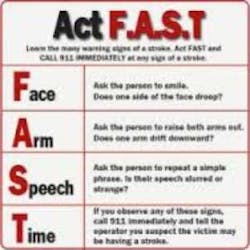A stroke occurs when one of the arteries to the brain is either blocked or bursts.(2) As a result, part of the brain does not get the blood it needs, so it starts to die. A transient ischemic attack (TIA) occurs when the blood supply to the brain is blocked for a short time. There are two types of TIAs, an Embolic Stroke or a Thrombotic Stroke. A hemorrhagic stroke occurs when a blood vessel in the brain bursts and spills blood into or around the brain. High blood pressure and aneurysms can make blood vessels weak enough to burst.(2)
There are different types of hemorrhagic stroke, including intracerebral hemorrhage and subarachnoid hemorrhage.(2) An aneurysm is a type of subarachnoid hemorrhage, and is a weak spot on the wall of an artery that bulges out into a thin bubble. As it gets bigger, the wall may weaken and burst. If it bursts, blood leaks inside or around the brain.
Signs of stroke include: sudden numbness or weakness of the face, arm or leg, especially on one side of the body; sudden confusion, trouble speaking or understanding; sudden trouble seeing in one or both eyes; sudden trouble walking, dizziness or loss of balance; and/or sudden severe headache with no known cause. Make a note of the time when any symptoms first appear. If given within three hours of the first symptom, there is an FDA-approved clot-buster medication that may reduce long-term disability for the most common type of stroke.
If you have any of these symptoms or see someone else having them, call 9-1-1 immediately! Act F.A.S.T. Fast treatment at the hospital can have better results.
Recently published “Guidelines for the Prevention of Stroke in Women: A Statement for Healthcare Professionals from the American Heart Association/American Stroke Association” is an educational tool for neurologists.(3) It is endorsed by the American Association of Neurological Surgeons and Congress of Neurological Surgeons.
The purpose of the statement is to summarize data on stroke risk factors that are unique to and more common in women than men and to expand on the data provided in prior stroke guidelines and cardiovascular prevention guidelines for women. The guideline focuses on the risk factors distinctive to women, such as reproductive factors, and those that are more common in women, including migraine with aura, obesity, metabolic syndrome, and atrial fibrillation.
To view a PDF of an ad for Act F.A.S.T., click here.
Tips for preventing stroke include: eating a healthy diet; maintaining a healthy weight; being physically active; not smoking; limiting alcohol use; having your cholesterol checked; monitoring and controlling your blood pressure; managing your diabetes; and taking any prescribed medication for the above conditions.(4)
The American Heart Association (AHA) has resources for professionals, as does Stroke Awareness.(5,6) Listen to the stroke song! It may help you to recall symptoms if you are ever in a stressful situation.(7) View the words here.(8)
And last, but not least, there have been links stated between periodontal disease and stroke. Data from the study: The Oral Infections and Vascular Disease Epidemiology Study (INVEST) provide evidence of a direct relationship between periodontal microbiology and subclinical atherosclerosis.(9)
This relationship exists independent of C-reactive protein. Extensive in-person cardiovascular risk factor measurements, a carotid scan with high-resolution B-mode ultrasound, white blood cell count, and C-reactive protein values were obtained, including carotid artery intima-media thickness. Another study showed that periodontal disease, a treatable condition, is an independent risk factor for cerebral ischemia in men and younger subjects.(10)
On the other side of the equation, another study showed no convincing evidence that proves periodontal disease causes heart disease or stroke, or that treating periodontal disease reduces the risk of those diseases.(11) Periodontal disease and heart disease share common risk factors, including smoking, age and diabetes, which is possibly why the diseases often occur in the same person.
While we need a large, long-term study to prove if dental disease causes heart disease and stroke, we know there is a link. There is no downside to prevention and treatment of periodontal disease.
References
1. http://www.presidency.ucsb.edu/ws/index.php?pid=20508#axzz1IIjVldn1.
2. National Stroke Association. Explaining Stroke. http://www.stroke.org/site/DocServer/ExplainingStroke_web.pdf?docID=3321.
2. Bushnell C, McCullough LD, Awad IA, Chireau MV, Wende N. Fedder, Karen L. Furie, Virginia J. Howard, Judith H. Lichtman, Lynda D. Lisabeth, Ileana L. Piña, Mathew J. Reeves, Kathryn M. Rexrode, Gustavo Saposnik, Vineeta Singh, Amytis Towfighi, Viola Vaccarino, and Matthew R. Walters , on behalf of the American Heart Association Stroke Council, Council on Cardiovascular and Stroke Nursing, Council on Clinical Cardiology, Council on Epidemiology and Prevention, and Council for High Blood Pressure Research. AHA/ASA Guideline: Guidelines for the Prevention of Stroke in Women: A Statement for Healthcare Professionals From the American Heart Association/American Stroke Association. Stroke. published online February 6, 2014. http://stroke.ahajournals.org/content/early/2014/02/06/01.str.0000442009.06663.48.full.pdf+html.
4. http://www.cdc.gov/Features/Stroke/.
5. http://www.strokeassociation.org/STROKEORG/Professionals/Stroke-Resources-for-Professionals_UCM_308581_SubHomePage.jsp.
6. http://www.strokeawareness.com/mass-media-stroke-resources/.
7. http://www.thestrokesong.com/smile_thestrokesong.mp3.
8. http://www.thestrokesong.com/words.html.
9. Desvarieux M, Demmer RT, Rundek T, Boden-Albala B, Jacobs DR, Sacco RL, and Papapanou PN. Periodontal Microbiota and Carotid Intima-Media Thickness: The Oral Infections and Vascular Disease Epidemiology Study (INVEST). Circulation. 2005 February 8; 111(5): 576.
10. Grau AJ, Becher H, Ziegler CM, Lichy C, Buggle F, Kaiser C, Lutz R, Bültmann S, Preusch M, Dörfer CE. Periodontal disease as a risk factor for ischemic stroke. Stroke. 2004 Feb; 35 (2):496-501. Epub 2004 Jan 5.
11. P. B. Lockhart, A. F. Bolger, P. N. Papapanou, O. Osinbowale, M. Trevisan, M. E. Levison, K. A. Taubert, J. W. Newburger, H. L. Gornik, M. H. Gewitz, W. R. Wilson, S. C. Smith, L. M. Baddour. Periodontal Disease and Atherosclerotic Vascular Disease: Does the Evidence Support an Independent Association?: A Scientific Statement From the American Heart Association. Circulation, 2012; DOI: 10.1161/CIR.0b013e31825719f3.










